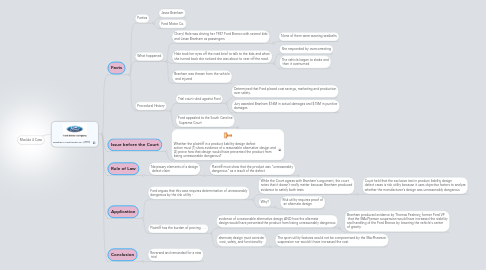
1. Branham v. Ford Motor Co., (2010)
1.1. Facts
1.1.1. Parties
1.1.1.1. Jesse Branham
1.1.1.2. Ford Motor Co.
1.1.2. What happened
1.1.2.1. Cheryl Hale was driving her 1987 Ford Bronco with several kids and Jesse Branham as passengers
1.1.2.1.1. None of them were wearing seatbelts
1.1.2.2. Hale took her eyes off the road brief to talk to the kids and when she turned back she noticed she was about to veer off the road.
1.1.2.2.1. She responded by overcorrecting
1.1.2.2.2. The vehicle began to shake and then it overturned
1.1.2.3. Branham was thrown from the vehicle and injured
1.1.3. Procedural History
1.1.3.1. Trial court ruled against Ford
1.1.3.1.1. Determined that Ford placed cost savings, marketing and production over safety.
1.1.3.1.2. Jury awarded Branham $16M in actual damages and $15M in punitive damages
1.1.3.2. Ford appealed to the South Caroline Supreme Court
1.1.3.2.1. Branham brought a product liability - design defect claim against Ford
1.2. Issue before the Court
1.2.1. Whether the plaintiff in a product liability design defect action must (1) show evidence of a reasonable alternative design and (2) prove how that design would have prevented the product from being unreasonable dangerous?
1.3. Rule of Law
1.3.1. Necessary elements of a design defect claim
1.3.1.1. Plaintiff must show that the product was "unreasonably dangerous" as a result of the defect
1.3.1.1.1. Consumer Expectation Test
1.3.1.1.2. Risk Utility Test
1.4. Application
1.4.1. Ford argues that this case requires determination of unreasonably dangerous by the risk utility -
1.4.1.1. While the Court agrees with Branham's argument, the court notes that it doesn't really matter because Branham produced evidence to satisfy both tests
1.4.1.1.1. Court held that the exclusive test in product liability design defect cases is risk utility because it uses objective factors to analyze whether the manufacturer's design was unreasonably dangerous
1.4.1.2. Why?
1.4.1.2.1. Risk utility requires proof of an alternate design
1.4.2. Plaintiff has the burden of proving. . .
1.4.2.1. evidence of a reasonable alternative design AND how the alternate design would have prevented the product from being unreasonably dangerous
1.4.2.1.1. Branham produced evidence by Thomas Feahney, former Ford VP that the MAcPherson suspension would have increased the stability and handling of the Ford Bronco by lowering the vehicle's center of gravity.
1.4.2.2. alternate design must consider cost, safety, and functionality
1.4.2.2.1. The sport utility features would not be compromised by the MacPhearson suspension nor would it have increased the cost
1.5. Conclusion
1.5.1. Reversed and remanded for a new trial
